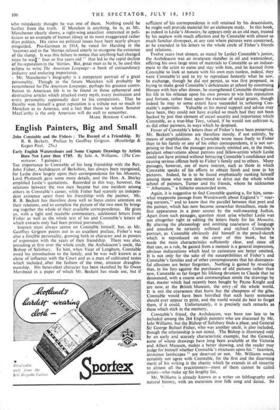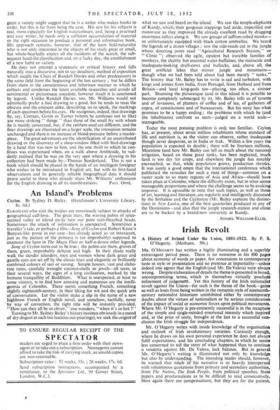English Painters, Big and Small
THE importance to Constable of his long friendship with the Rev. John Fisher, Archdeacon of Berkshire, has always been recognised, for Leslie drew largely upon their correspondence for his Memoirs, Lord Plymouth gave some more details, and the Hon. A. Shirley amplified Leslie's quotations. Recorded in this way, however, the relations between the two men became but one incident among others in Constable's career, while Fisher had scarcely an indepen- dent existence apart from his friendship- with the painter. Mr. R. B. Beckett has therefore done well to focus entire attention on their relations, and to complete the picture of the two men by bring- ing together the whole of their available correspondence. He gives us, with a light and readable commentary, additional letters from Fisher as well as the whole text of his and Constable's letters of which extracts only had been printed previously.
Interest must always centre on Constable himself, but, as Mr. Geoffrey Grigson points out in an excellent preface, Fisher's was also a forcible personality, growing both in character and in powers of expression with the years of their friendship. There was also, presiding at first over the whole circle, the Archdeacon's uncle, the Bishop of Salisbury. To him, when Vicar of Langham, Constable owed his introduction to the family, and he was well known as a cleric of influence with the Court and as a man of cultivated tastes which included, after the fashion of the time, amateur draughts- manship. His benevolent character has been sketched by Sir Owen Morshead in a paper of which Mr. Beckett has made use, but if sufficient of his correspondence is still retained by his descendants, he might well provide material for an elaborate study. In this book, as indeed in Leslie's Memoirs, he appears only as an old man, treated by his nephew with much affection and by Constable with almost as much familiar disrespect, at any rate where pictures were concerned, as he extended in his letters to the whole circle of Fisher's friends and relations.
Twelve years (not sixteen, as stated by Leslie) Constable's junior, the Archdeacon was an inveterate sketcher in oil and watercolour, offering his own large store of materials to Constable as an induce- ment to the artist to come and stay with him, and he learned from Constable to look at nature with his own eyes (unless, indeed, they were Constable's) and to try to reproduce honestly what he saw. In exchange, though he did not persist, as was first proposed, in trying to make good Constable's deficiencies at school by construing Horace with him after dinner, he strengthened Constable throughout his life in his reliance upon his own powers to win him reputation and fortune, rather than upon the exercise of social graces, though indeed he may to some extent have succeeded in softening Con- stable's asperities. Valuable as his moral support and advice may have been, they could not have availed so much had they not been backed by just that element of social security and importance which Constable, as a true-blue Tory, valued, if he would not cultivate it, as did other painters, in ways which he despised.
Fewer of Constable's letters than of Fisher's have been preserved. Mr. Beckett 's additions are therefore mostly, if not entirely, by means of amplification. As Constable wrote more freely to Fisher than to his family or any of his other correspondents, it is not sur- prising to find that the passages previously omitted are, in the main, petulant observations about patrons and fellow-artists which Leslie could not have printed without betraying Constable's confidence and causing serious offence both to Fisher's family and to others. Many passages, however, are of more interest, such as those in which Constable speaks of his efforts to obtain finish and tone in his pictures. Indeed, he is to be found emphatically ranking himself among those who were determined to drive out the whole white school of painters, Turner and his friends, whom he nicknames "Albanians," a hitherto unrecorded term.
Again, it is suggestive to find Constable quoting a, for him, some- what inapposite passage from Wordsworth about England's" roar- ing torrents," and to know that the parallel between that poet and the painter, which has now become somewhat threadbare, made its first appearance in a poor sonnet by the well-meaning Judkirt. Apart from such passages, question must arise whether Leslie was not altogether right in editing the letters freely for his Memoirs. By altering the phraseology and omitting coarseness of language and anecdote he certainly softened and stylised Constable's portrait, as Constable obviously did himself in the pencil-sketch which is reproduced on the cover of this book, but he made the main characteristics sufficiently clear, and since all that can, as a rule, be gained from a memoir is a general impression, obvious indiscretions which lead to caricature are better omitted. It is not only for the sake of the susceptibilities of Fisher's and Constable's families and of other contemporaries that his disrespect- ful allusions are better forgotten. Nothing is gained by revealing that, in his fury against the purchasers of old pictures rather than new, Constable so far forgot his lifelong devotion to Claude that he denounced, with a coarse and commonplace simile the drawings by that, master which had recently been bought by Payne Knight and are now, at the British Museum, the envy of the whole world. It is not the coarseness that hurts but the cheapness of the gibe. Constable would have been horrified that such hasty sentences should ever appear in print, and the world would do best to forget them, if it could. Unfortunately, it is precisely such remarks as these which stick in the memory.
Constable's friend, the Archdeacon, was born too late to be included among the 264 English painters who are discussed by Mr. Iolo Williams, but the Bishop of Salisbury finds a place, and General Sir George Bulteel Fisher, who was another uncle, is also included, though the relationship is not noted. The Bishop is illustrated only by an early and scarcely characteristic example, but the General, some of whose drawings have long been available at the Victoria and Albert Museum, makes a better showing, and the reader may judge for himself whether Constable's strictures upon his" heartless, atrocious landscapes" are deserved or not. Mr. Williams would certainly not agree with Constable, for the first and the disarming merit of his writing is the charity which he extends in all sincerity to almost all the practitioners—most of them cannot be called artists—who make up his lengthy list.
Mr. Williams is already known as a writer on bibliography and natural history, with an excursion into folk song and dance. So great a variety might suggest that he is a writer who makes books to order, but this is far from being the case. His zest for his subjects is real, more especially for English watercolours, and, being a practised and easy writer, he needs only a sufficient accumulation of material or the right occasion to produce a personal and informative book. His approach remains, however, that of the keen field-naturalist who is not only interested in the objects of his study great or small, but whole-heartedly enjoys all the incidents of the search, the sub- sequent hand-list classification and, on a lucky day, the establishment of a new habit or variety.
He does not attempt a systematic or critical history and falls naturally into a discursive, not to say desultory, method of exposition which recalls the Chats of Randall Davies and other predecessors in the same field from the beginning of the last century ; but he differs from them in the conscientious and laborious manner in which he collects and condenses the latest available researches and avoids all sentimental or picturesque anecdote, however much it is sanctioned by legend. Unlike Randall Davies, too, Mr. Williams would not admittedly prefer a bad drawing to a good, but he tends to treat the obscure and the eminent alike, describing, so to speak, the markings of each specimen before his eyes. He recognises, indeed, that drawings by, say, Cotman, Girtin or Turner (whom he confesses not to like) are more striking" things " than those of the small fry with whom • he is mainly concerned, but, if the epithets used are different, and the finer drawings are illustrated on a larger scale, the intonation remains unchanged and there is no increase of blood-pressure before a master- piece. The great adventures are the identification of an unattributed drawing or the discovery of a shop-window filled with bird-drawings by a hand that was new to him, and the one thrill to which he con- fesses was experienced when, on a walk above Ambleside, he sud- denly realised that he was on the very spot where a drawing in his collection had been made by—Thomas Sunderland. This is not a book which should be placed in the hands of an intelligent foreigner who wishes to be introduced to English art, but with its first-hand observations and its generally reliable biographical data it should prove useful to those who already share Mr. Williams' enthusiasm for the English drawing in all its manifestations. PAUL OPPB.



































 Previous page
Previous page